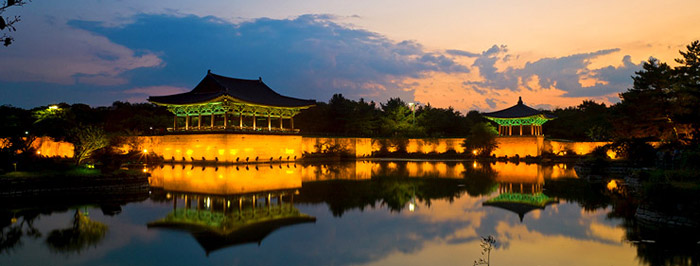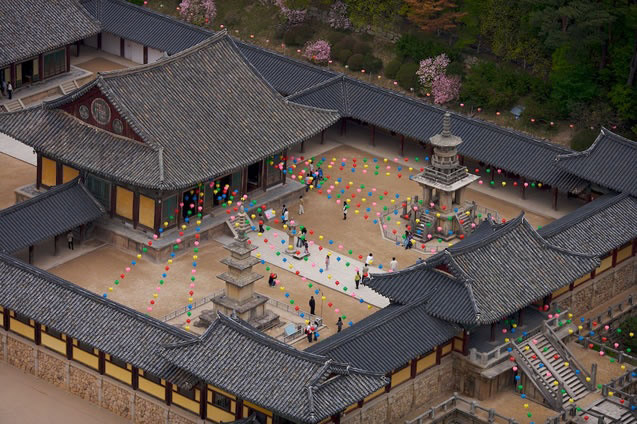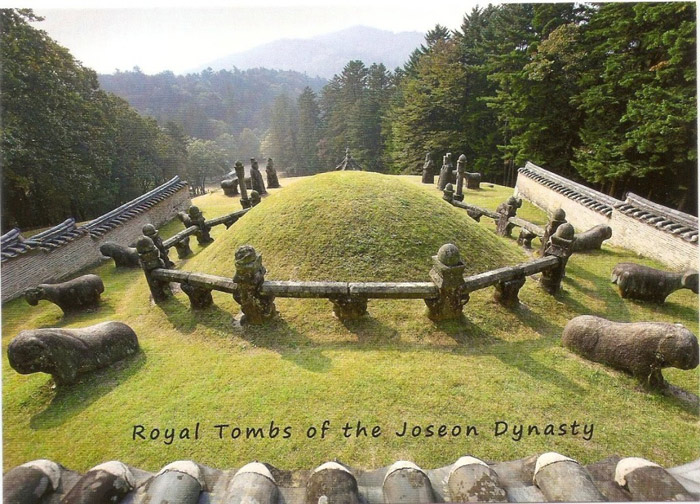Gyeongju historical site
Unesco's Scientific, Educational and Cultural Organization has recognized Korea's Gyeongju Historical Monument as a World Cultural Heritage in 2000.

Gyeongju historical site is known as an area with extremely diverse Buddhist artworks ranging from bas-reliefs, carved statues and countless temples and pagodas with architectural designs. special. In addition, the ancient capital of Gyeongju is also attractive and famous for its ancient beauty of traditional history and culture.

Gyeongju was originally the capital of Korea during the Silla dynasty . The capital was dubbed the " museum without walls " with the tombs, temples, pagodas and palaces reminiscent of dynasties that span more than 1,000 years of the history of the ancient kingdom of Silla.
Historically, Gyeongju became the capital of Korea since 57 BC after the Silla dynasty came to power. It continues to be the capital for a long time, nearly a fifth of the country's 5,000-year history. With that long history, Gyeongju is home to a lot of scenic spots and historical monuments than any other place in kimchi. If you visit all the sites of the Gyeongju Historical Monument complex, it will take a lot of time, so if you visit this area, visitors often choose some famous and famous places. Best turn: Bulguksa Temple; Seokguram cave; Royal tomb area; Gyeongju National Museum; Yangdong Wolseong Village .

Bulguksa Temple - Buddha Temple is a temple dating back to the 8th century. Bulguksa Temple is considered the most beautiful temple in Korea. In front of the prayer house are two famous stone pagodas , Dabotap - the temple of treasures and Seokgatap - Buddha's temple. Bulkuksa is built entirely of stone, wooden halls and corridors, and the temple roof is decorated with traditional Korean motifs. Bulkuksa preserved 7 national treasures : Dabotap stone tower - Da Bao Thap, Seokgatap stone tower - Thich Gia tower, Lien Hoa bridge and That Bao bridge, Thanh Van bridge and Bach Van bridge, meditation Buddha statue, Buddha statue A-di-da and relics tower shaped like a stone lantern. According to records at the temple, the Bulguksa was originally a small temple built in 528 under King Beopheung. However, according to Tam Quoc dien, the temple was built in 751 under the reign of King Gyeongdeok, led by General Kim Daeseong to inform his parents and was completed in 774, under the Hyegong Dynasty. After Kim Daeseong died, the temple was named Bulguksa as it is today.

Seokguram cave is considered one of the most beautiful Buddhist temples in the world and is a typical illustration of Silla architecture. This cave not only has cultural, historical and religious significance, but also an architectural masterpiece that makes anyone who comes here must be amazed and amazed.

The royal tomb is a complex consisting of many tombs of Korean kings and queens. Among them: Gwoereung Mausoleum; Oreung Tombs Park; Baeri Samneung Mausoleum; Gyeongju Tomb Park Hwangnam-ri Gobungun; Nodong Tomb / Noseo-ri Tomb Park; Park Tomb of Seoakri Gobungun; Tomb of Kim Yushin; The underwater tomb of King Munmu. But the most famous in this ruins is Tumuli Tomb Park which is located in the 23-tomb complex among 200 tombs found in Gyeongju. Tombs covered with verdant grass have become a symbol of the ancient capital of Gyeongju.

Gyeongju National Museum is home to the largest collection of artifacts and Buddhist relics from the Silla dynasty outside Seoul. In addition, the museum also showcases many cultural masterpieces from some Asian countries.

Yangdong Village Wolseong is home to about 150 traditional thatched roof cottages. Some houses are over 500 years old. Built in the 14th-15th centuries, Yangdong Village is considered the two most representative historical clan villages for Korea. The layout and location of these villages - surrounded by forested mountains, facing a river and extended fields - has shown the unique culture of Confucian nobility in the early stages of the Joseon Dynasty (1392-1910). Yangdong Village is located in the northeast of Gyeongju. Although Gyeongju was the capital of the ancient kingdom of Silla thousands of years ago, Yangdong Village showed the characteristic of the Joseon Dynasty 550 years ago. Like Hahoe village, Yangdong is also a village of a family based on Confucian culture . But these two villages have differences: Both are villages built by one of them. Hahoe Village was created by the Ryu family, who left the original land to better live. They came to this place to open up, set up their homeland, and Hahoe Village was born there. And Yangdong village shows an old marriage habit of Koreans, that is, when people get married, they return to the wife's house to live. Yangdong Village was formed by a man who married his wife and went home to live there. Therefore, the village was established before the Confucian practice of living was introduced into Korean society. This village is a typical example of ancient Korean architecture . So far, the Korean Government has invested heavily to maintain the life of the villagers as part of its heritage conservation.

Cheomseongdae Observatory in Gyeongju historical monument is the oldest observatory still in Asia. The station was built during the reign of Queen Seonduk in 634.

Gyeongju historic site is recognized by Unesco under the criteria (ii), (iii).
Criterion (ii): Gyeongju historical monument is one of the special high-value relics in the development of Buddhism in Korea.
Criterion (iii): Gyeongju historical site is the ancient capital of the Silla dynasty and is the area with the most valuable architecture, culture and history in Korea. This place is not only a historical evidence but also a place that contains Korean traditional and unique traditions.
- South Korea discovered new evidence of human sacrifices
- The historical villages of Korea: Hahoe and Yangdong
- 11 famous historical events thought to be real but were fictional
- 5 famous historical places are haunted
- Surprised with rare historical series hard to find
- 15 impressive historical moments
- Historical center Bridgetown and Garrison - World cultural heritage in Barbados
- 4 historical facts that many of us don't know about
- Reviving Thang Long by virtual reality technology
- Time's most influential photos of all time
- Relic area of the Imperial Citadel of Thang Long - Hanoi
- Marvel at 10 historical photos that have never been revealed
 Suzhou classic bonsai garden - China
Suzhou classic bonsai garden - China Chau Nguyen Dynasty
Chau Nguyen Dynasty Thai Son Mountain - World Wonder
Thai Son Mountain - World Wonder Ancient villages of Shirakawa-go and Gokayama
Ancient villages of Shirakawa-go and Gokayama